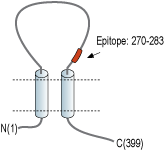Overview
- Peptide CRPIYEFHGLYEEK, corresponding to amino acid residues 270-283 of human P2X1 receptor (Accession P51575). Extracellular loop.

 Cell surface detection of P2X1 by direct flow cytometry in live intact mouse P815 mast cells:___ Cells.
Cell surface detection of P2X1 by direct flow cytometry in live intact mouse P815 mast cells:___ Cells.
___ Cells + Rabbit IgG Isotype control-APC (#RIC-001-APC).
___ Cells + Anti-P2X1 Receptor (extracellular)-APC Antibody (#APR-022-APC), (1 µg). Cell surface detection of P2X1 by direct flow cytometry in live intact human MEG-01 megakaryoblastic leukemia cells:___ Cells.
Cell surface detection of P2X1 by direct flow cytometry in live intact human MEG-01 megakaryoblastic leukemia cells:___ Cells.
___ Cells + Rabbit IgG Isotype control-APC (#RIC-001-APC).
___ Cells + Anti-P2X1 Receptor (extracellular)-APC Antibody (#APR-022-APC), (2.5 µg). Cell surface detection of P2X1 by direct flow cytometry in live intact mouse J774 macrophage cell line:___ Cells.
Cell surface detection of P2X1 by direct flow cytometry in live intact mouse J774 macrophage cell line:___ Cells.
___ Cells + Rabbit IgG Isotype control-APC (#RIC-001-APC).
___ Cells + Anti-P2X1 Receptor (extracellular)-APC Antibody (#APR-022-APC), (5 µg).
- Prasad, M. et al. (2001) J. Physiol. 537, 667.
- Florenzano, F. et al. (2002) Neuroscience 115, 425.
- Ashcroft, F.M. et al. (2000) Ion Channels and Disease Ed 1, p. 405, Academic Press, San Diego.
- Khakh, B.S. et al. (2001) Pharmacol. Rev. 53, 107.
- Ding, Y. et al. (2000) J. Auton. Nerv. Syst. 81, 289.
- Lê, K.T. et al. (1998) J. Neurosci. 18, 7152.
- Robertson, S.J. et al. (2001) Curr. Opin. Neurobiol. 11, 378.
- Dunn, P.M. et al. (2001) Prog. Neurobiol. 65, 107.
- Kim, M. et al. (2001) EMBO J. 20, 6347.
- Burnstock, G. (2001) Trends Pharmacol. Sci. 22, 182.
- Oury, C. et al. (2003) Blood 101, 3969.
The P2X receptors belong to the ligand-gated ion channel family and are activated by extracellular ATP.
The structure and function of the P2X receptors, investigated mainly using in vitro models, indicate their involvement in synaptic communication, cell death, and differentiation.
Seven mammalian P2X receptor subtypes (P2X1–P2X7) have been identified and cloned1-3. All P2X receptor subtypes share the same structure of intracellular N- and C-termini two membrane-spanning domains and a large extracellular loop.
All P2X receptor subtypes can assemble to form homomeric or heteromeric functional channels with the exception of P2X6, which only seems to function as part of a heteromeric complex4-9.
The various P2X receptor subtypes show distinct expression patterns. P2X1-6 have been found in the central and peripheral nervous systems, while the P2X7 receptor is predominantly found in cells of the immune system4. The P2X1 receptor is present in smooth muscle, cerebellum, dorsal horn spinal neurons, and platelets where it is suggested to play a regulatory role during in vivo homeostasis and thrombosis3,4,10,11.
Application key:
Species reactivity key:
Anti-P2X1 Receptor (extracellular) Antibody (#APR-022) is a highly specific antibody directed against an extracellular epitope of the human protein. The antibody can be used in western blot, immunocytochemistry, immunohistochemistry, and indirect flow cytometry applications. It has been designed to recognize P2X1 receptor from rat, mouse, and human samples.
Anti-P2X1 Receptor (extracellular)-APC Antibody (#APR-022-APC) is directly conjugated to Allophycocyanin (APC) fluorophore. This conjugated antibody has been developed to be used in immunofluorescent applications such as direct flow cytometry and live cell imaging.
